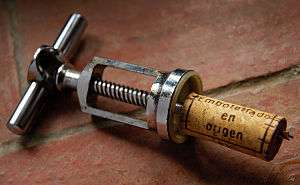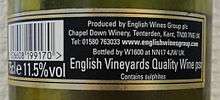Quality Wines Produced in Specified Regions
Quality Wines Produced in Specified Regions (often abbreviated to QWpsr or simply "quality wines") is a quality indicator used within European Union wine regulations. The QWpsr category identifies wines with protected geographical indications. The European Union regulates and defines the status of "quality wines" according to production method, management and geographical location. Its original, fundamental role is in differentiating quality wines from table wines, broadly in line with the system traditionally employed by the French government, amended to account for the preferences and methodology of Italian and German growers, among others in the EU.


History
In 1962, shortly after the Treaty of Rome created the European Economic Community (EEC, or "Common Market") a set of rules were drawn up in which the normal common organisation of the market for a type of product – normally limited to a pricing system, rules on intervention and a system for trade with third-party countries – was extended in several areas in order to accommodate the diverse interests of wine production within individual member states. The wine sector required regulation of more technical aspects, such as the development of wine-growing potential, wine production techniques, oenological practices and processes, rules on designation and presentation, rules governing the movement and release for consumption of wine products, protection of designations of origin, and so on.
At the time the EEC had only six members, four of which were major wine producers; France, Germany, Italy and Luxembourg. The French initiated Community recognition of their principles which differentiated between "quality wines" and "table wines" in order to standardise the marketing of exported wine. Germany and Luxembourg in particular objected to any barriers to the development of their wine industry, which was geared towards the production of wines with a readily available outlet, nor did they wish to change the practice of chaptalisation (the enrichment of wine by adding sugar) which was foreign to many parts of France and forbidden in Italy. French production was highly regulated, where Italians were proud of the free commercialisation of their wines. Where plantation was strictly regulated in some states, it was practically uncontrolled in others.
The QWpsr classification surmounted these problems, dictating specific treatment for ‘quality wines’, excluding them from classic market management mechanisms such as distillation and storage, while requiring stricter discipline for production and control. Early agreements respected the broad outlines of French national legislation and were also acceptable to Italy. Whereas many guiding principles (including the maintenance of traditional practices and distinguishing between categories of wines) continue to apply without any fundamental changes, many, like freedom of plantation and non-application of intervention measures to quality wines, have gradually been amended. At one point, new plantings were banned to prevent over-production, while the same problem (the infamous "wine lakes" of the last few decades) has led to widespread distillation of quality wines being permitted in years of surplus production, known as "crisis distillation". Today, with domestic demand falling and a boom in sales of New World wine, European growers are seeing increasing amounts of quality wines destined to become ethanol and other biofuels.[1]
Rules and regulations
Quality wines legislation does not specify exactly which wines should be subject to its rules and member states are permitted to regulate their own production in order to preserve traditional practices. In fact the very concept of QWpsr differs between northern and southern Europe; countries like Germany are regulated by quality first and little importance is given to geographical location, while other growers are regulated by geographical considerations first, as is the case with the Spanish Denominación de Origen regulations. As a consequence, where German wines are automatically classified as QWpsr, French, Italian and Spanish wines only attain that status after being officially approved.
The current QWpsr regulations, last modified in 2000, stipulate the following areas in which member states must make specific provisions:
- lists of suitable grape varieties
- details of required wine-growing methods
- the regulation of enrichment and sweetening practices
- stipulation of a minimum natural alcoholic strength
- maximum yield by hectare
- analysis of wines and assessment of organoleptic characteristics
- ensuring that grape production, wine making and development are carried out within the specified region
- the circumstances under which quality wine may be downgraded to table wine status.[2]
List of national QWpsr designations
The following national levels of wine classification correspond to QWpsr. Many EU countries have more than one QWpsr level, and in such cases, there is typically a national hierarchy between them, although they all follow the same EU rules.[3][4]
| Country | National classification corresponding to QWpsr | |
|---|---|---|
| Higher level | Lower level | |
| Prädikatswein (Qualitätswein besonderer Reife und Leseart) | Qualitätswein, Districtus Austriae Controllatus | |
| Gecontroleerde oorsprongsbenaming (Dutch), Appellation d’origine contrôlée (French) | ||
| Гарантирано и контролирано наименование за произход (ГКНП), "Guaranteed and controlled designation of origin" (GKaNP) | Гарантирано наименование за произход (ГНП), "Guaranteed designation of origin" (GNP) | |
| Οίνος Ελεγχόμενης Ονομασίας Προέλευσης (ΟΕΟΠ), "Controlled Designation of Origin" (OEOP) | ||
| Jakostní víno s přívlastkem | Jakostní víno | |
| Appellation d'origine contrôlée (AOC) | Appellation d'origine vin délimité de qualité supérieure (AOVDQS or VDQS) | |
| Prädikatswein (formerly Qualitätswein mit Prädikat, QmP) | Qualitätswein (Qualitätswein besonderer Anbaugebiete, QbA) | |
| Ονομασία Προέλευσης Ανωτέρας Ποιότητας (ΟΠΑΠ), "Appellation of Origin of Superior Quality" (OPAP) | Ονομασία Προέλευσης Ελεγχόμενη (ΟΠΕ), "Controlled Appellation of Origin" (OPE) | |
| Minőségi bor, "Quality wine" | Védett eredetű bor, "Wine with protected origin" | |
| Denominazione di origine controllata e garantita (D.O.C.G.), may also be written in German as Kontrollierte und garantierte Ursprungsbezeichnung on wines from Bolzano | Denominazione di origine controllata (D.O.C.), may also be written in German as Kontrollierte Ursprungsbezeichnung on wines from Bolzano | |
| Marque nationale + Appellation d'origine (A.O.) | ||
| Denominazzjoni ta’ Origini Kontrollata (D.O.K.) | ||
| Denominação de Origem Controlada (D.O.C.) | Indicação de proveniência regulamentada (I.P.R.), Denominação de Origem (D.O.) | |
| Vin cu denumire de origine controlată (D.O.C.) | ||
| Akostné víno s prívlastkom | Akostné víno | |
| Denominación de origen calificada (DOCa), Vino de pago calificado | Denominación de origen (DO), Vino de calidad con indicación geográfica, Vino de pago | |
| Quality wine (English vineyard quality wine psr, Welsh vineyard quality wine psr) | ||
Similar denominations in non-EU countries
- Algeria: Appellation d'origine garantie (AOG)
- Argentina : Denominación de Origen Controlada (DOC) and Indicación Geográfica (IG)
- Australia: Geographical Indication (GI)[5]
- Brazil : Denominação de Origem (DO) and Indicação de Procedência (IP)
- Canada: Vintners Quality Alliance (VQA)
- Chile: Denominación de Origen de Región Vitícola
- Mercosur: Denominación de Origen Reconocida[6] and Indicación Geográfica Reconocida
- Morocco: Appellation d'origine contrôlée (AOC) and Appellation d'origine garantie (AOG)
- New Zealand: Geographical Indication (GI)
- San Marino: Identificazione d’Origine (IO)
- South Africa: Wine of Origin (W.O.)
- Switzerland: Appellation d'origine contrôlée (AOC)
- Tunisia: Appellation d'origine contrôlée (AOC)
- United States: American Viticultural Area (AVA)
See also
- Protected designation of origin – EU legislation against non-genuine produce
- Traditional food
References
- Commission Pulls Plug on EU Wine Lake
- Working paper, February 2006, Wine, Common Market Organisation Archived 6 March 2007 at the Wayback Machine
- Commission Regulation (EC) No 607/2009 of 14 July 2009 laying down certain detailed rules for the implementation of Council Regulation (EC) No 479/2008 as regards protected designations of origin and geographical indications, traditional terms, labelling and presentation of certain wine sector products
- Commission Regulation (EC) No 753/2002 of 29 April 2002 laying down certain rules for applying Council Regulation (EC) No 1493/1999 as regards the description, designation, presentation and protection of certain wine sector products, consolidated version up until Commission Regulation (EC) No 1471/2007 of 13 December 2007
- Australian Wine and Brandy Corporation Regulaions 1981
- Reglamento vitivinícola del Mercosur